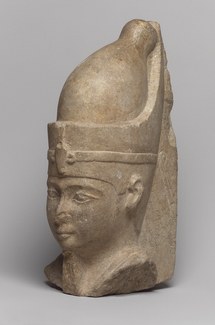Head of a Ptolemaic King

In this portrait the Egyptian traditional false beard is combined with a double crown representing the union of Upper and Lower Egypt. Known as the Pschent or Sekhemti (the “Two Powerful Ones”), the double crown combined the white crown of Upper Egypt (Hedjet) and the red crown of Lower Egypt (Deshret).
A typically Hellenistic royal diadem, whose tied ends are visible on either side of the back pillar, counterbalances the otherwise purely Egyptian combination of iconographic motifs. The diadem is in fact the only element that allows a modern viewer to recognize the image as a product of the Ptolemaic era rather than of earlier periods in Egyptian history.
P. E. Stanwick. Portraits of the Ptolemies: Greek Kings as Egyptian Pharaohs. Austin: University of Texas Press, 2002. 124, E10, figs. 167-168.